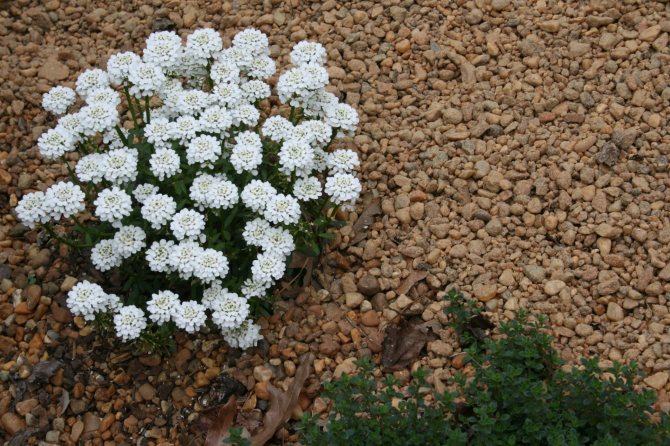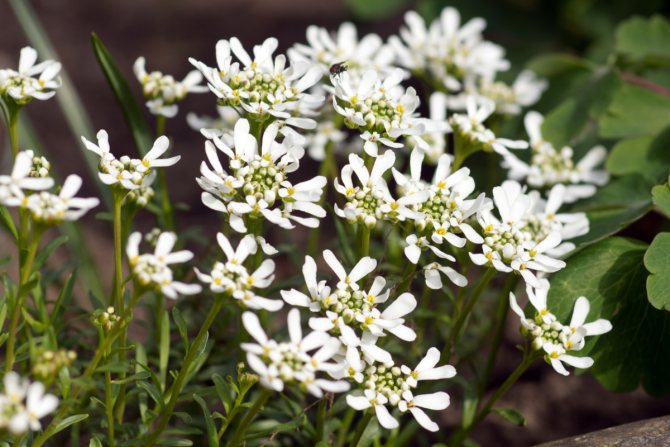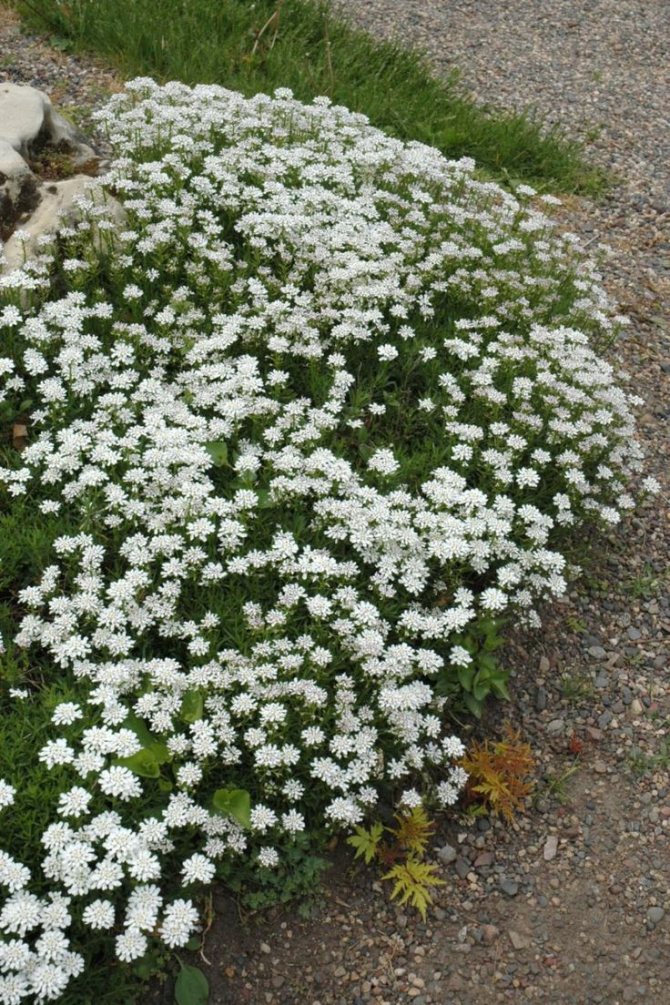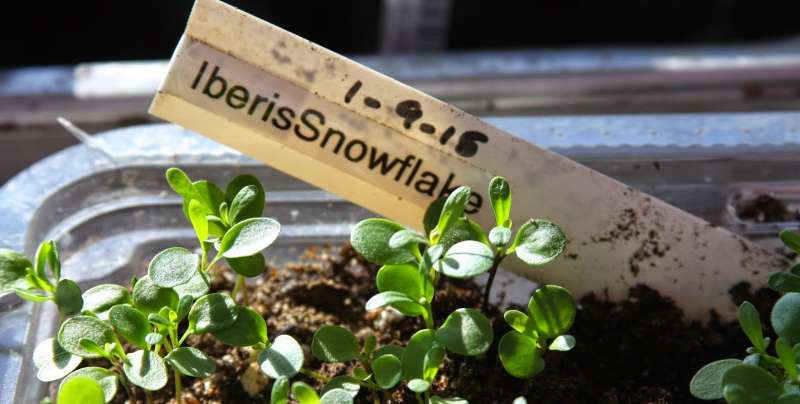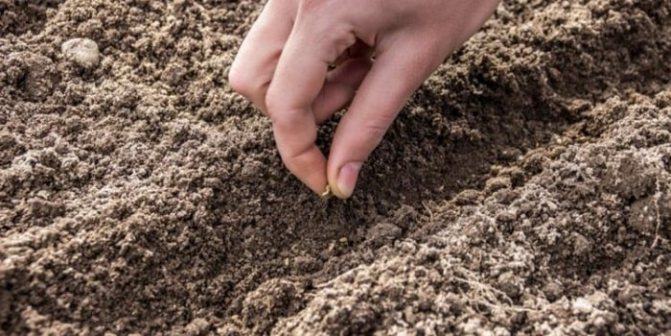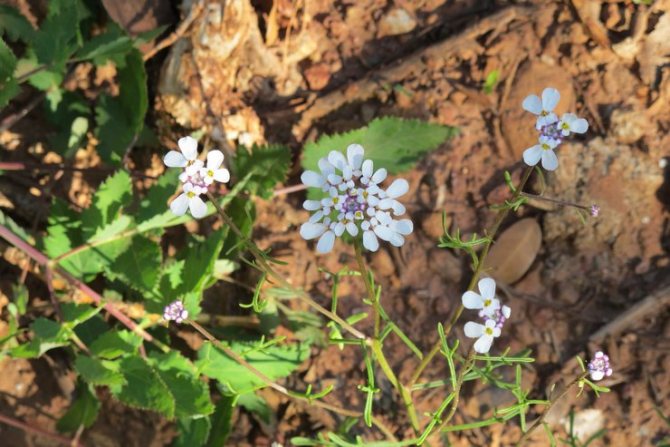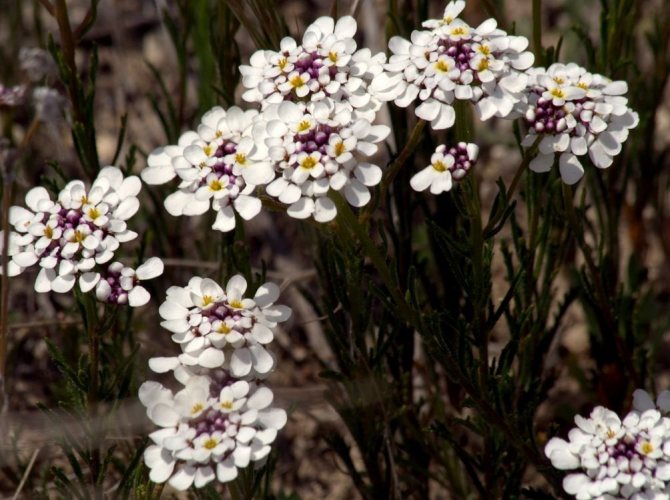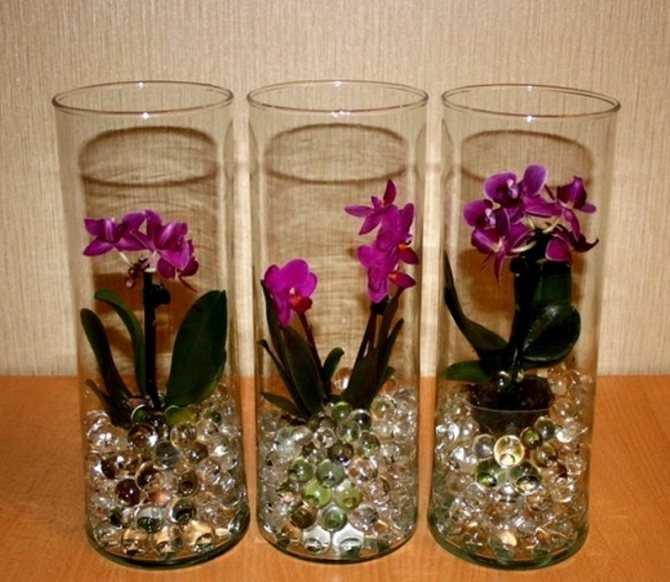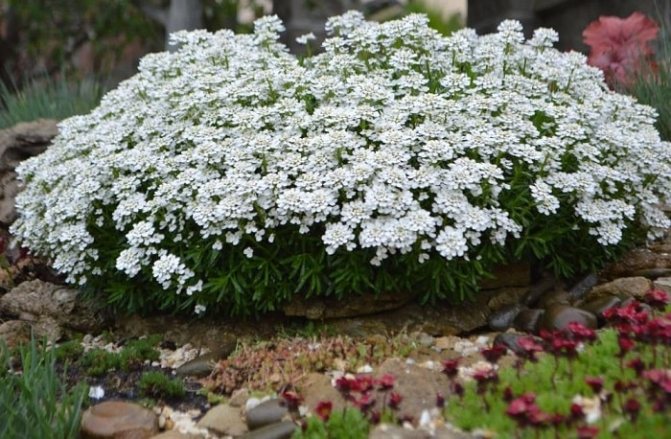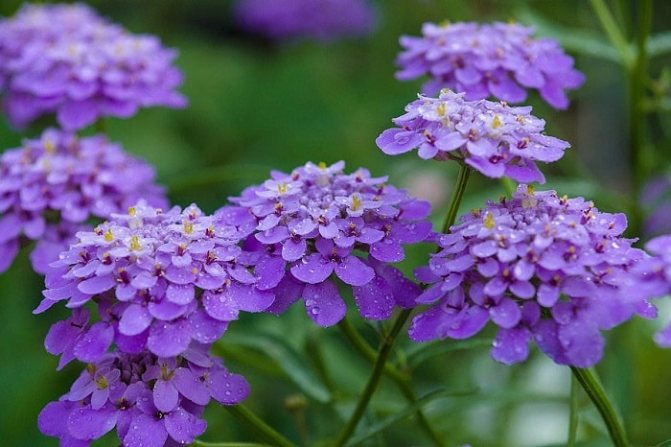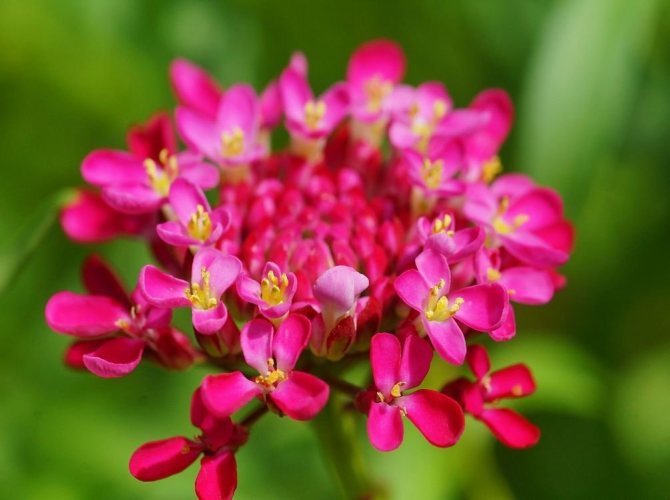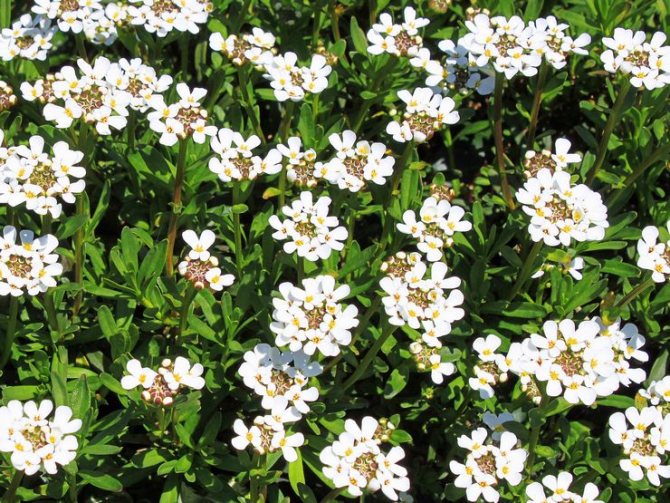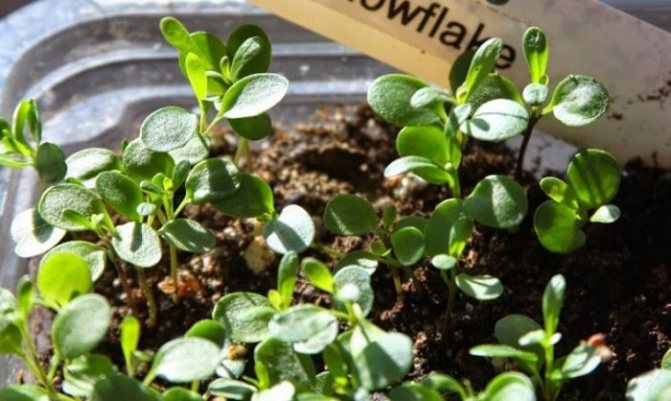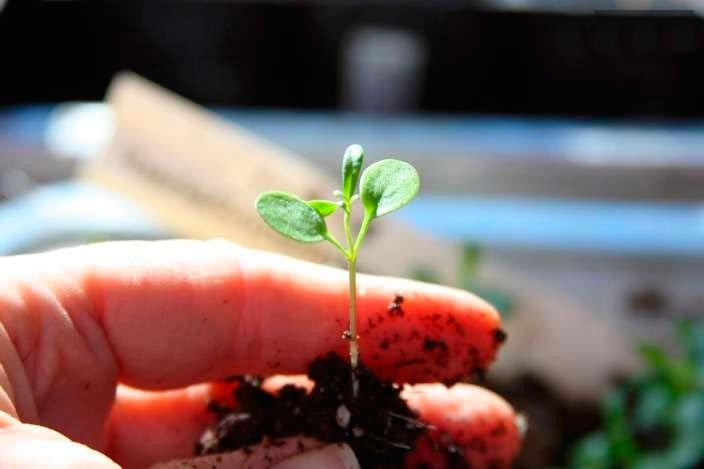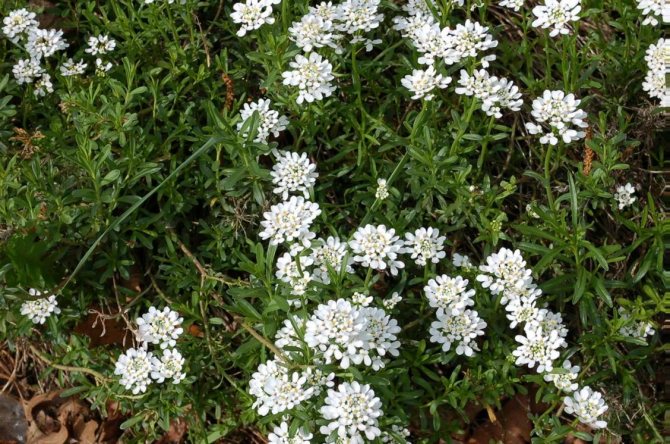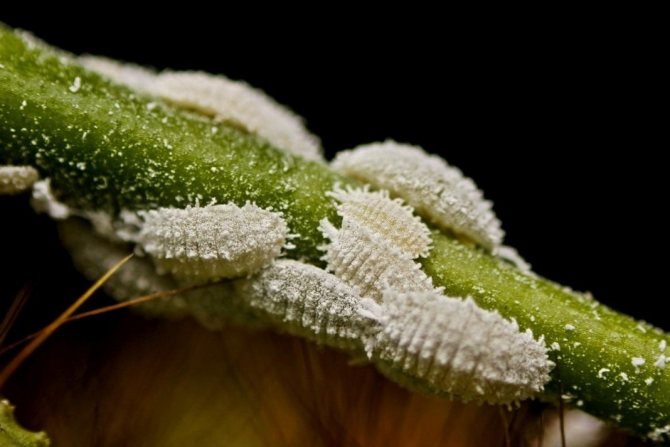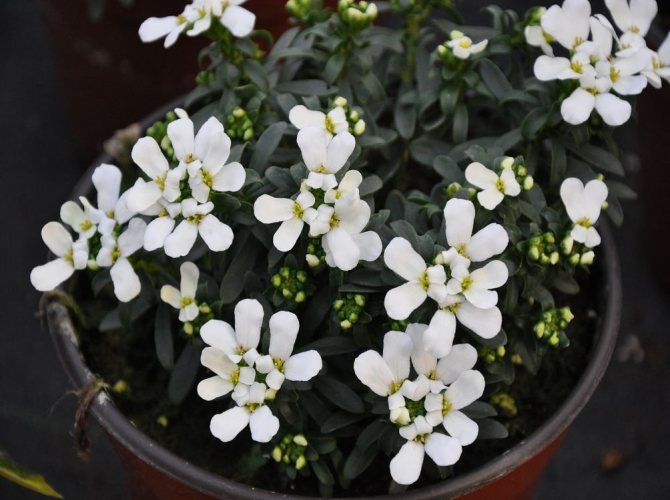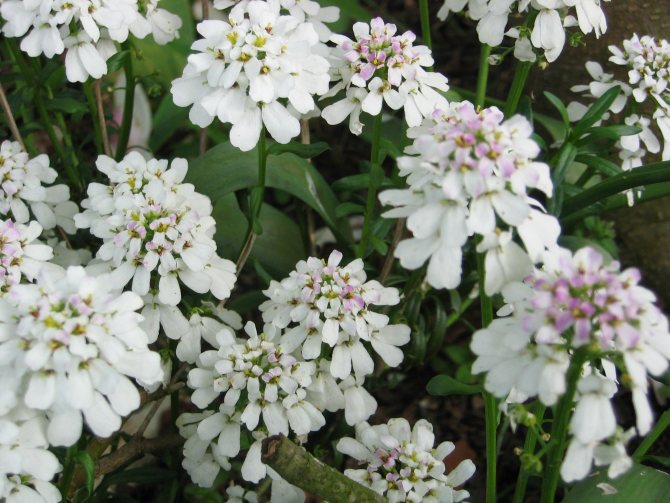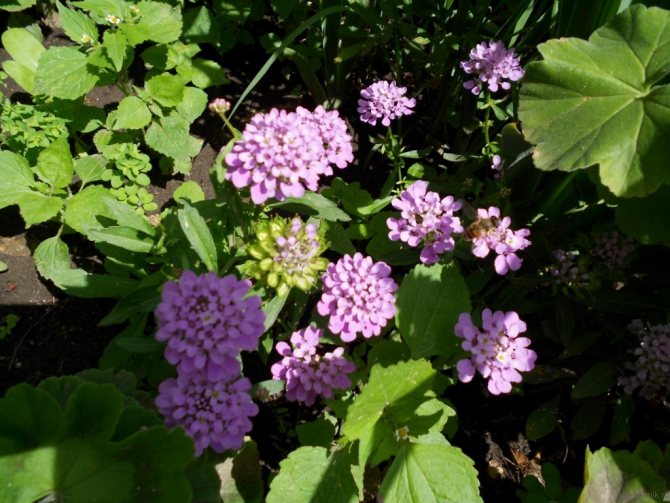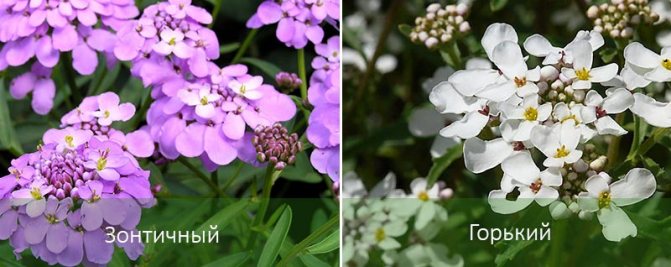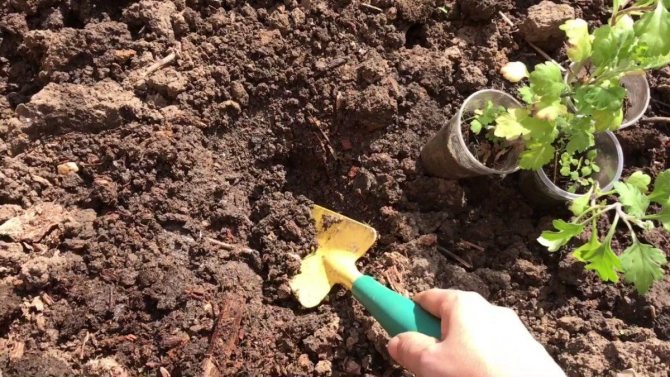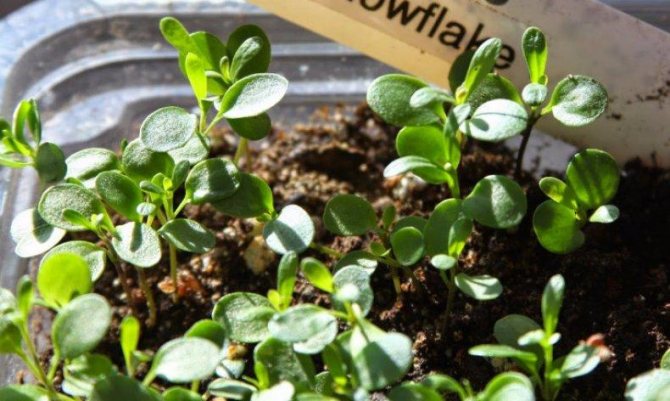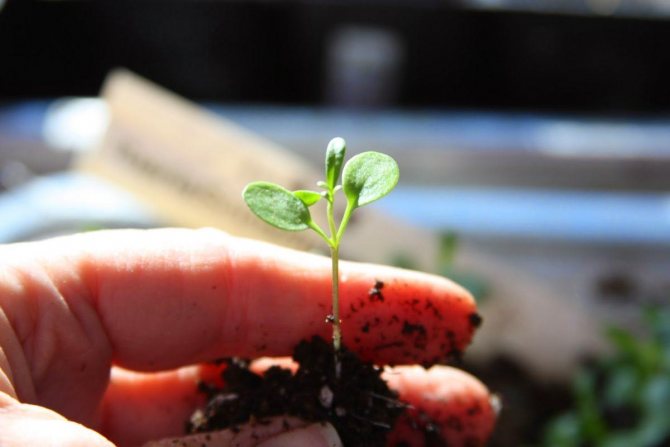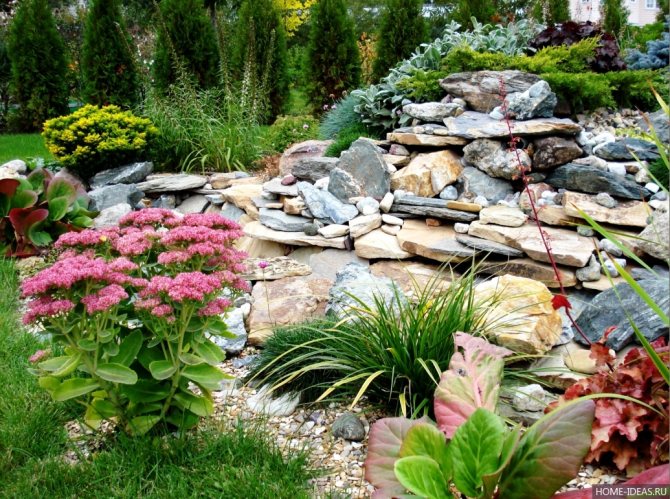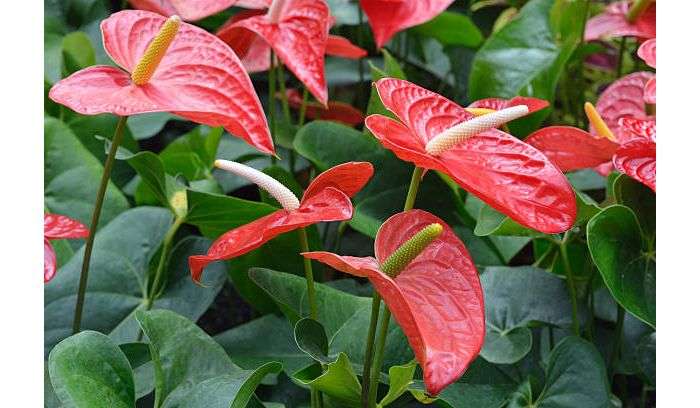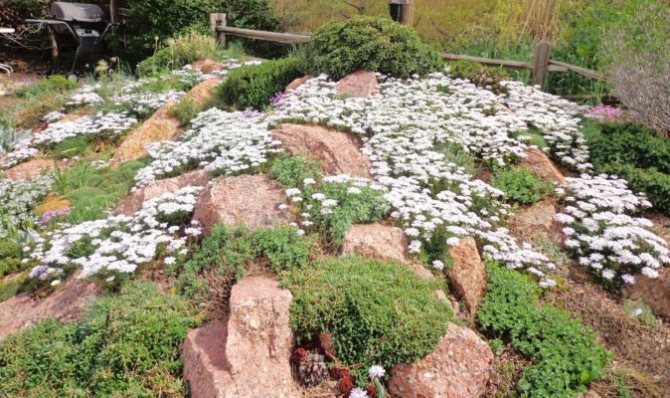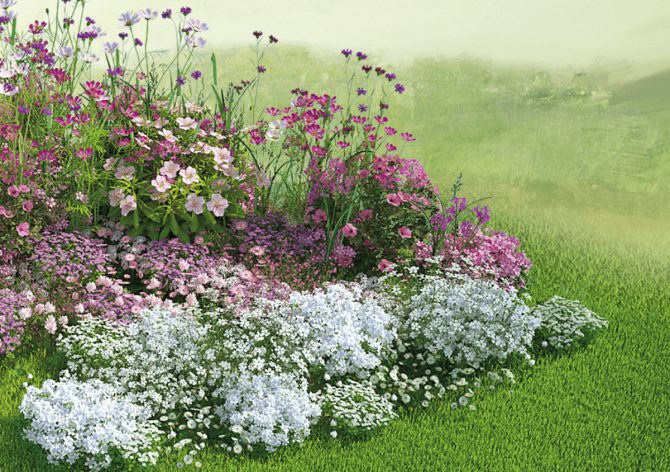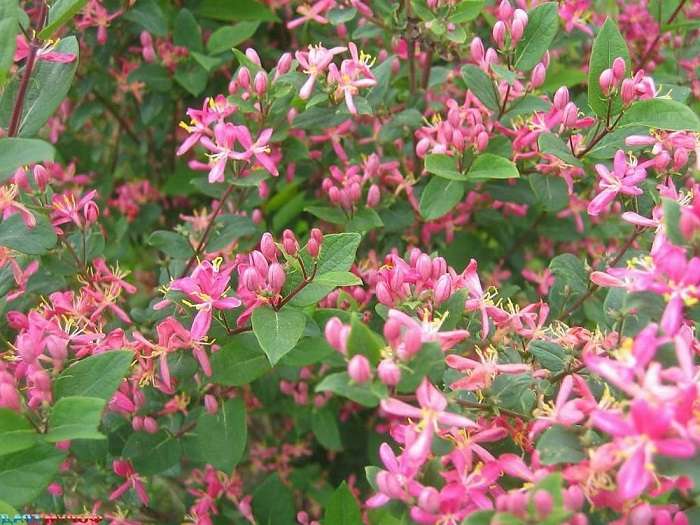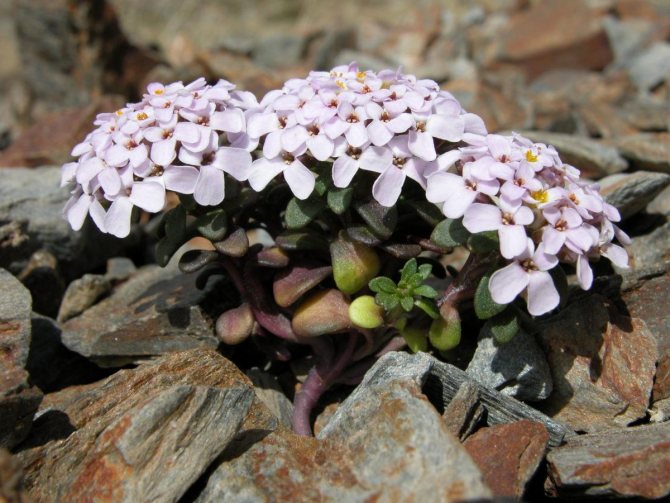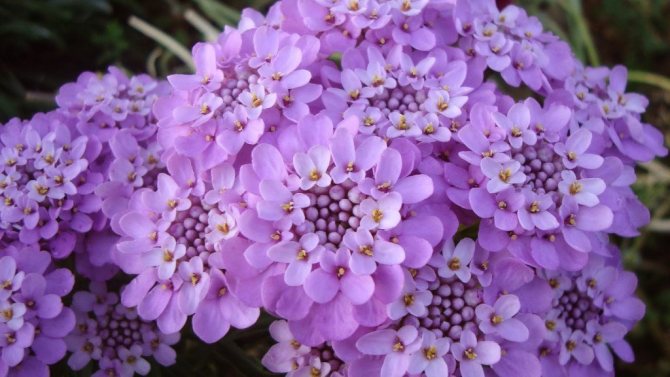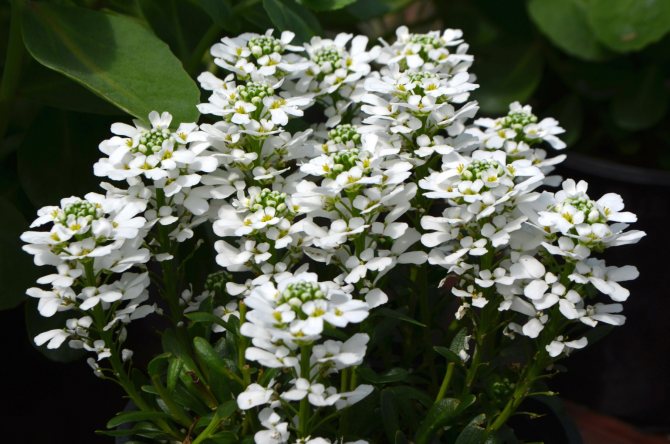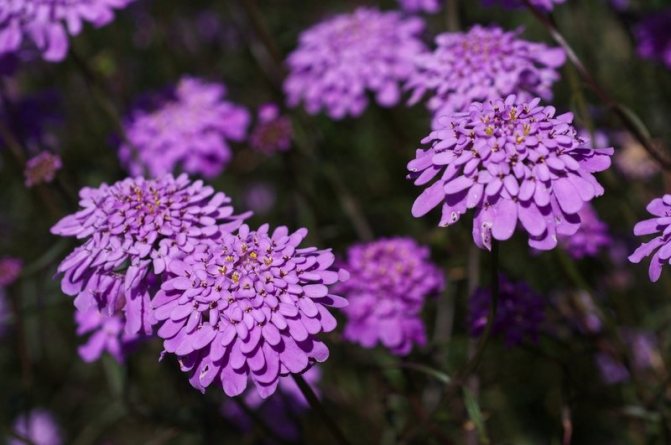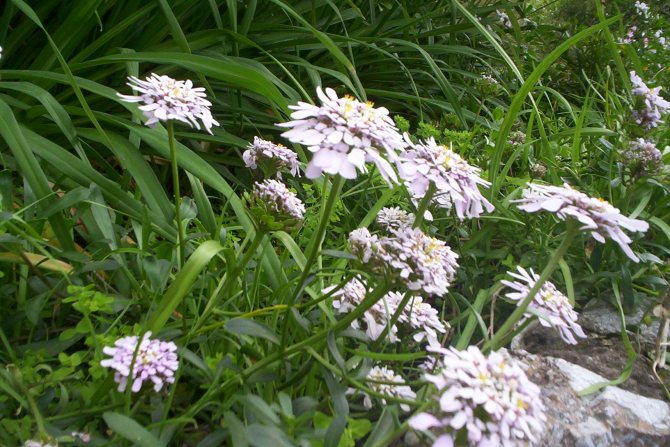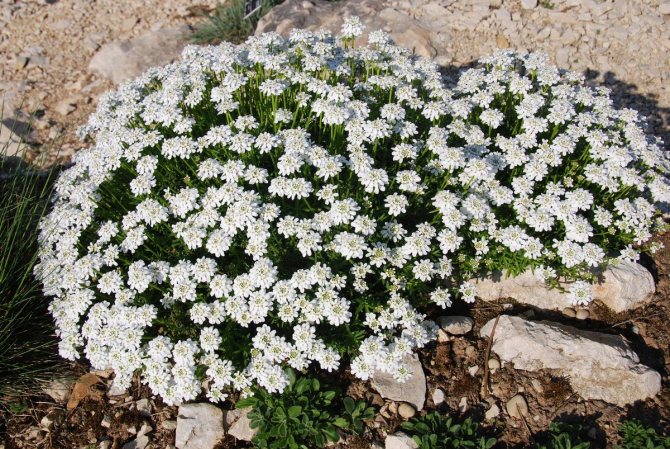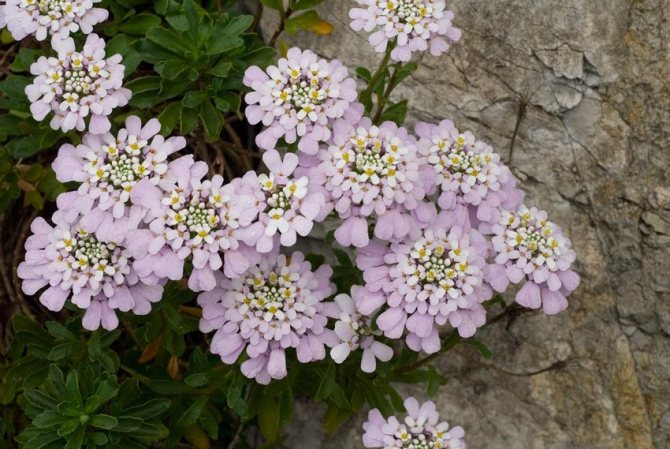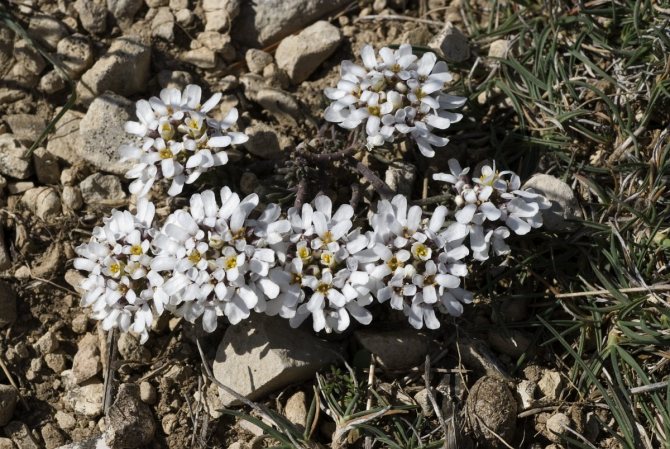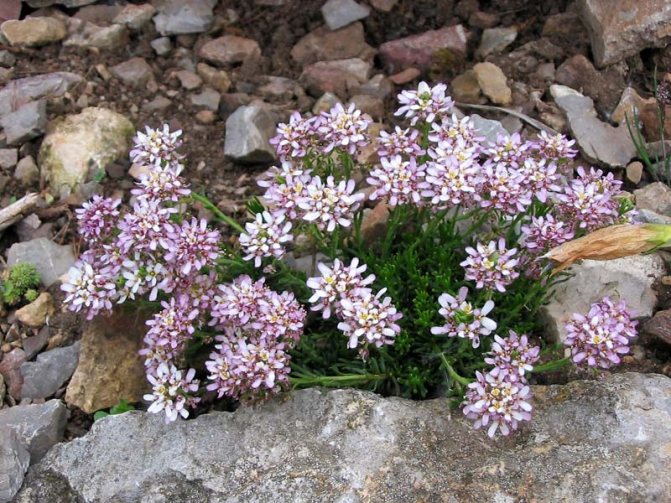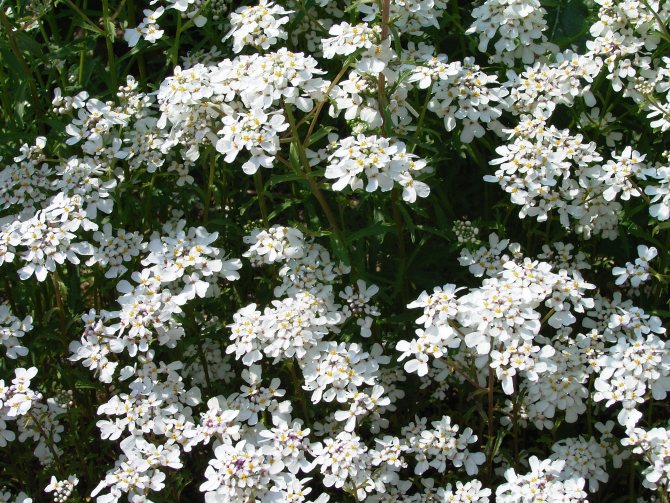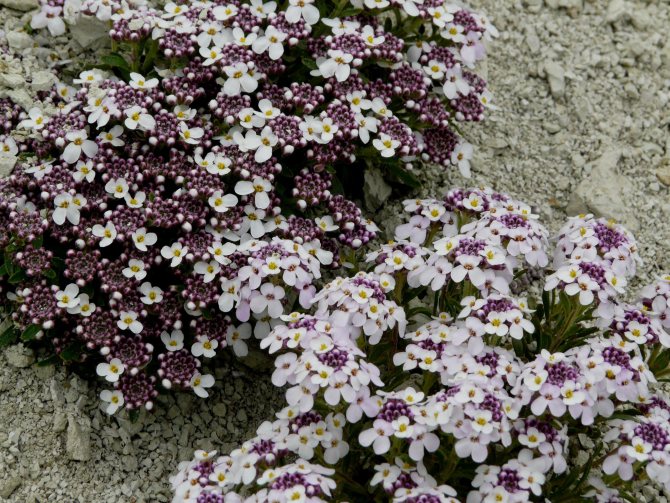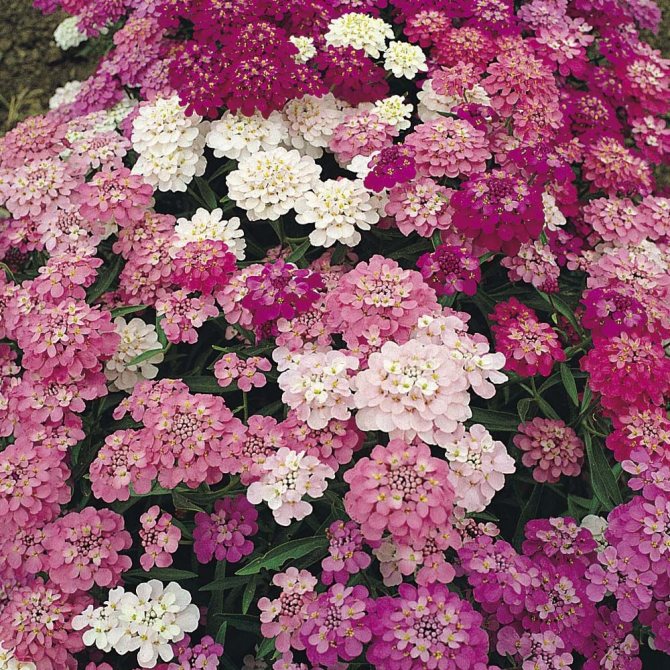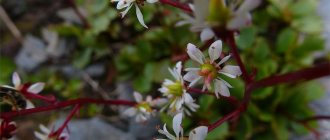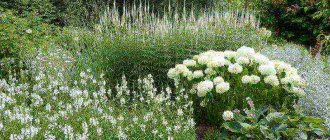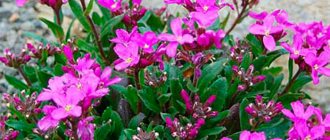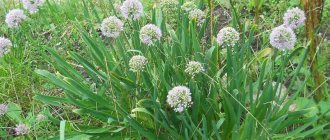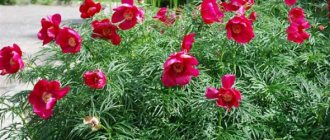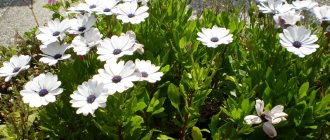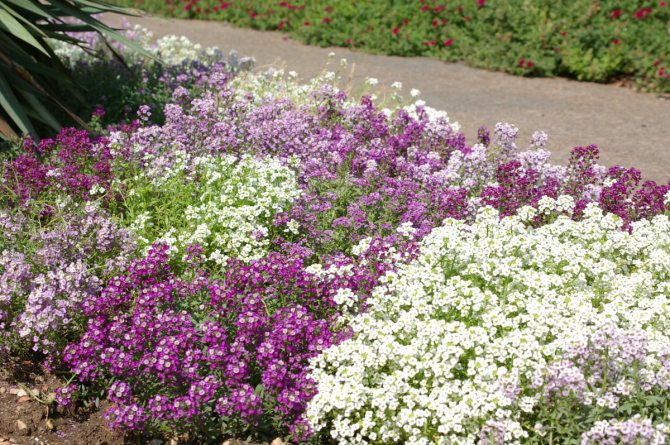
Iberis is an evergreen flowering plant belonging to the Cruciferous family. It is represented by thermophilic annual herbaceous species and perennial frost-resistant dwarf shrubs. During the flowering period, low shrubs are covered with white, red, lilac or purple inflorescences, spreading a subtle honey aroma around. Due to the unusual structure of the flowers: two petals are longer than the next adjacent petals, the plant received the name - variegated, and due to its ability to grow in the breaks of the walls, it was called stennik.
Where to plant
Like most flowering crops, Iberis prefers well-lit locations. In extreme cases, it can be light partial shade. With a lack of lighting, the bushes begin to stretch out, and the flowering becomes less abundant.
Regarding the soil, then the natural habitat of the growth of Iberis leaves an imprint. In the wild, it "lives" in mountainous areas. It is not surprising that it will be better for bushes on light loams and rocky soils.
The area where the Iberis bed is planned should not be flooded. The plant will not survive stagnation of moisture.
What climate is suitable for
In the wild, Iberis is found mainly in the mountains of the southern part of Europe and Asia Minor, in the Caucasus, in the Crimea and on the banks of the Don, therefore the optimal climate for it is hot or temperate. It tolerates frost persistently, but does not react well to sudden temperature changes and lack of snow. Accordingly, it is better to cover the planting for the winter - at too low temperatures and a lot of precipitation, the plant may die. Otherwise, Iberis is quite hardy, and its cultivation does not require any special conditions.
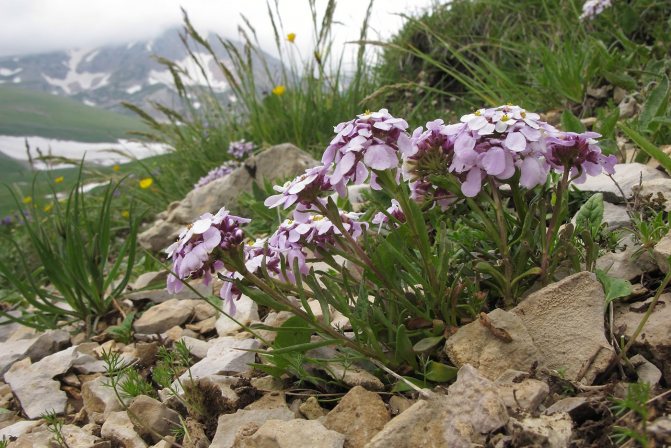

Iberis is an excellent honey plant
Growing Iberis: when to sow seeds outdoors
Iberis seeds are distinguished by high germination rate, which they retain for 4 years.
There are two ways to sow them on a flower bed:
- in the spring, at the end of April;
- before winter, in early October.
Spring sowing can be done in two passes by sowing a second batch of seeds after 3 weeks. Thus, when the bushes sown by the first have already faded, the latter will still delight with an abundance of inflorescences until the end of September.
Seeds need to be sown rarely, so that later you do not have to break through the crops. You can try to transplant torn seedlings, but they take root rather badly. It is better to sow less often at once. You should not fall asleep on top - just sprinkle with a thin layer of sand. When sowing in autumn, the garden bed can be covered with leaves for the winter.
Collection and storage of Iberis seeds
Seeds for sowing are sold in shops for summer residents and gardeners. But you can save money if you assemble them yourself. In addition, then the gardener will be sure that the plant variety he likes will grow on the flowerbed.
The seeds are placed in fruits - bivalve pods. They are flattened on the sides, with keeled valves. The pods come with a leathery wing. Each nest contains one ovule. Ripening and harvesting of fruits falls on August-September. After collecting, the seeds are husked, dried in a dark place.
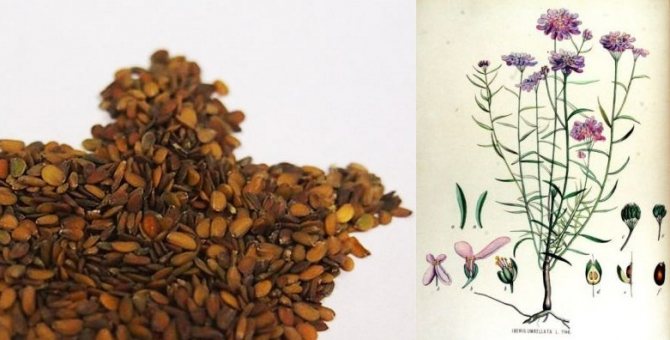

Iberis seeds
If the plant is already in the flower bed, then the seeds do not need to be harvested.Then next year a new generation of plants will appear thanks to self-seeding.
Reference. The seeds have their own age, which is considered from the day of collection. Well-ripened seeds remain viable for up to 4 years. But the further from the moment of collection, the worse this indicator.
Germination is lost faster under unfavorable storage conditions, which include:
- high humidity, including when collecting seed;
- exposure to direct sunlight;
- pelleting (coating seeds with various compounds to increase their size).
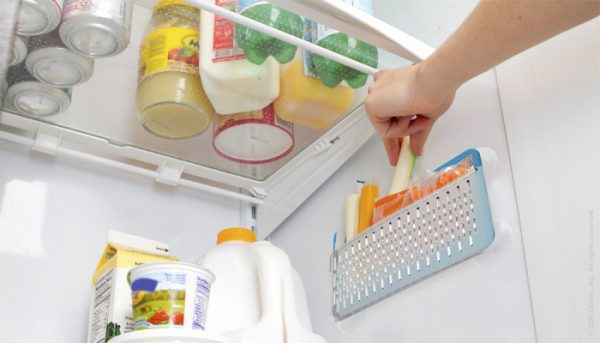

The refrigerator extends the shelf life of the seeds
The service life is increased if vacuum foil packaging is used for storage. At home, seeds are stored in paper or cloth bags, placed in a dry, cool, dark place at a temperature of 10 ... 15 ° C. If sealed packaging is used, then the seeds can be put in the refrigerator. Due to the low temperature, the germination ability lasts longer.
Seeds are sown for seedlings or already directly on the flower bed.
Iberis seed prices
Iberis seeds
Is it difficult to care for the plant
Even novice gardeners are capable of growing Iberises. This is an absolutely unpretentious crop, and most varieties have good frost resistance. For the southern regions, you can pick up thermophilic species, and for the central zone - more resistant Iberis.
It is easy to take care of flowers, because practically nothing needs to be done. If the summer is with precipitation, this moisture will be enough for the bushes. But in a drought, you need to walk through the beds with a watering can 2 times a week. Iberis can grow without top dressing, but if the soil is poor, it is advisable to add a mineral complex a couple of times per season. So it will be possible to maintain its flowering at the proper level. Inflorescences that have faded must be cut off so that they do not spoil the appearance of the bushes.
There are some nuances when growing perennial Iberis. At the end of flowering, they must be cut off, leaving no more than 2/3 of the height of the stems. And somewhere in the 4-5 year of life, plant the curtains: too thick, they bloom worse.
How to plant Iberis in open ground and take care of it in the garden - video
Small snow-white flowers of the low-growing ground cover of Iberis are hard to forget: they are like stars, generously scattered on a green carpet, attract the eye and give special tenderness and charm. The plant belongs to the cabbage family and is widespread from Europe and Asia Minor to the lower Don and the Caucasus. In the genus of Iberis, there are about forty varieties, among which there are both annual and perennial species.
Some varieties have good winter hardiness, and this has earned themselves love among gardeners. Both herbaceous and semi-shrub forms are grown, and each variety is attractive in its own way. The variety of uses of Iberis is so many-sided that one can only wonder: it is planted as a curb plant, it is used in compositions to create rockeries and alpine hills, it is widely used in floristry, and it is especially interesting - Iberis is often included in the bride's bouquet. Here is such an amazing plant that you should definitely plant in your garden.
Post-flowering care
To preserve the aesthetic appearance of the plantings after the end of flowering, it is necessary to trim the stems - at least 1/3 of them are removed. The pods that form in place of flowers can be harvested to produce seeds. When the plants reach the age of 5-6 years, they need to be planted, otherwise the inflorescences will become small and rare, as a result of which the flowerbed with Iberis will lose its decorative properties.
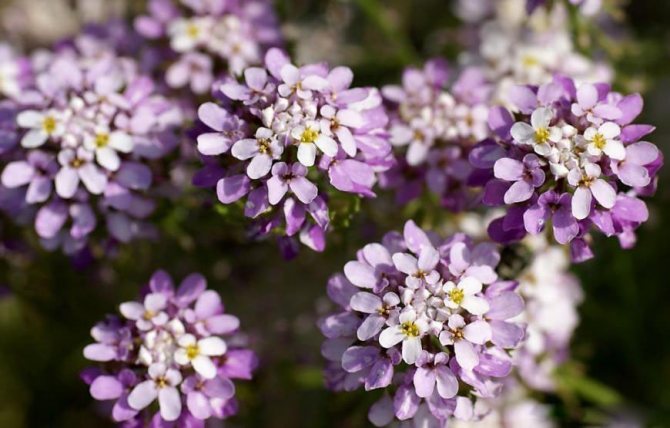

Iberis flowers are suitable for cutting, they are very often used in floristry
Despite the fact that most varieties of Iberis are frost-resistant plants, in temperate and harsh climates it is better to properly prepare it for winter.
In a southern climate in the last decade of autumn, it is enough to add a little compost to the soil around the plantings - it is important not to overdo it, otherwise the bushes will subsequently grow too much.
If Iberis grows in regions with harsh, snowless winters, plantings should be covered with fallen leaves, spruce branches or dry brushwood sprinkled with a small amount of hay.
Description of Iberis
The plant has a tap root system, which is why it is very painful to transplant, sometimes even dying. Iberis stems can be erect or creeping, depending on the variety. Small flowers and leaves cover the ground with a dense carpet, causing real admiration for the amazing lightness of almost air clouds. The color of the flowers is white, pink, red, lilac, lilac. Flowers about a centimeter in diameter are collected in dense umbellate inflorescences. Leaves are deep green in color. Flowering falls in May or August and lasts about two months, and annuals delight with flowers much longer. The aroma of Iberis is very pleasant, intense. After flowering, bivalve pods ripen with seeds that remain viable for up to five years.
Possible problems when growing a flower
Gardeners usually do not have problems with growing Iberis, but for this you need to choose the right site for planting a plant. On too heavy and wet soils, Iberis is affected by fungal diseases. If other plants belonging to the cruciferous family (cabbage, radish, etc.) previously grew on the site, it is highly likely that a pest called cabbage keel lives in the soil. It remains in the soil for a long time and is detrimental to the root system, so before planting it is best to treat the area with a fungicidal solution.
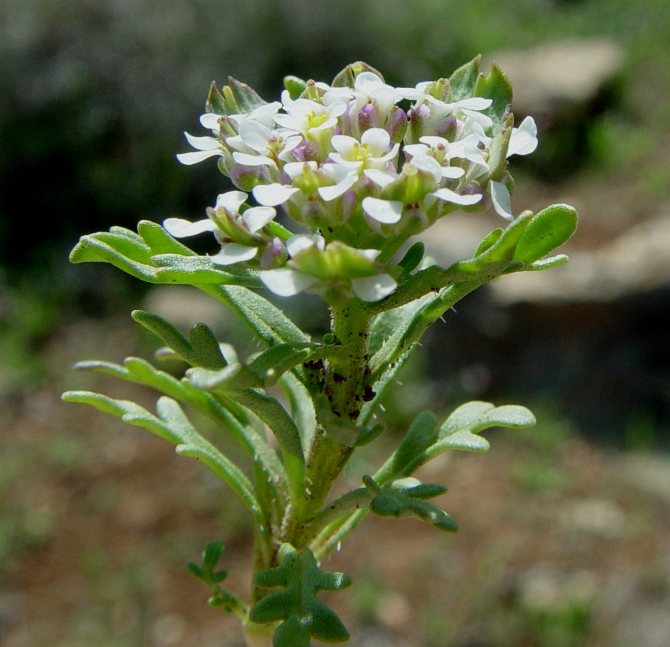

After pollination of the Iberis, small flattened pods with two valves ripen, inside there are small brown seeds
Among pests, Iberis is often affected by mealybugs, earthen fleas and aphids.
When characteristic lesions appear on the foliage, which indicate an infection of the plant, it is necessary to immediately treat it with special insecticide preparations.
Growing Iberis from Seeds When to Plant
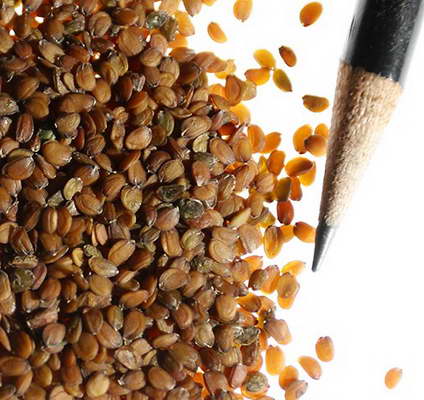

Iberis seeds photo
Iberis can be sown for seedlings or outdoors.
Sowing in open ground
In the spring, sowing in the garden of Iberis begins in April., often at intervals of two to three weeks, to produce plants with varying flowering intervals up to September. Seeds are planted to a depth of 1-2 cm, the distance between rows is 15-20 cm.
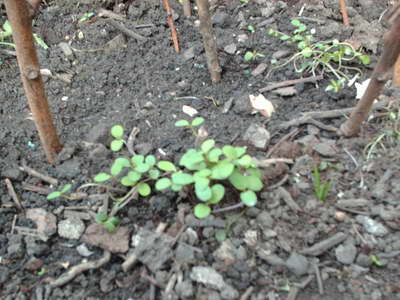

How to sow Iberis in the ground photo
When the plants sprout, the garden is weeded, and the seedlings break through, leaving a distance of 12-15 cm between them. The seeds sprout quite quickly, after a week or two, and the plants develop just as quickly. You just need to regularly water and feed about twice a month with complex fertilizers for flowering plants.
In the fall, Iberis is sown already with the onset of cold weather, in the month of October, waiting for the Indian summer to pass and the plants did not rise until spring.
How to plant Iberis from seeds for seedlings at home
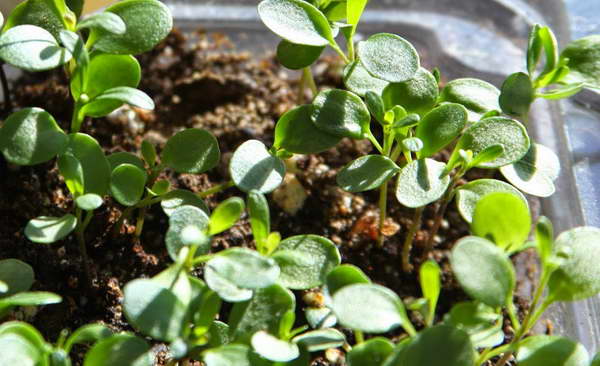

Iberis seedlings photo
To get seedlings as early as possible, you can sow seeds as early as late February - early March. The seeds are small, therefore, most often they are planted in a common container, scattered over the surface of the soil and lightly sprinkled with earth from above. Moisten everything with a spray bottle and cover with a plastic bag. The seeds will sprout in about a week or two, after which the bag is removed. And when the first pair of real leaves appears, they dive into separate cups.
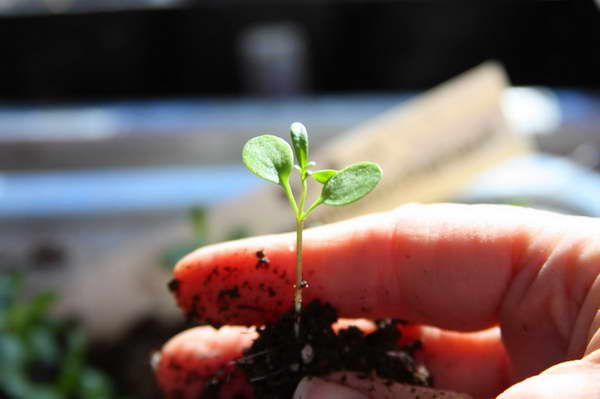

How to dive Iberis photo
Especially patient growers prefer to plant one or two seeds in separate cups so that they do not transplant the seedlings later.This saves time and effort: the seedlings do not get sick after transplanting and will bloom a week or two earlier.
What diseases and pests threaten Iberis?
Like many plants, Iberis is often invaded by harmful insects. Mealybugs, cabbage aphids and earthen beetles are especially unpleasant for the plant. You can fight pests with both folk remedies and chemicals. For example, a soap solution (300-400 g of liquid potassium soap per 10 liters of water) will help get rid of cabbage aphids.
If round holes have appeared on the leaves of Iberis, this means that the earthen flea has "worked". It is not difficult to drive it away: it is necessary to moisten the soil around the bush. But mealybugs can be destroyed only with the help of insecticides. If one treatment does not bring the desired result, repeat after 1-2 weeks.
Iberis is also exposed to fungal diseases, especially its root system. For prophylaxis, before planting seedlings, it is recommended to treat the garden with a fungicide, but if, nevertheless, the plant is infected, it must be urgently dug from the site and destroyed. To avoid fungal diseases, it is necessary to strictly monitor so that the soil does not become waterlogged.
How, where and when to plant Iberis seedlings in the ground
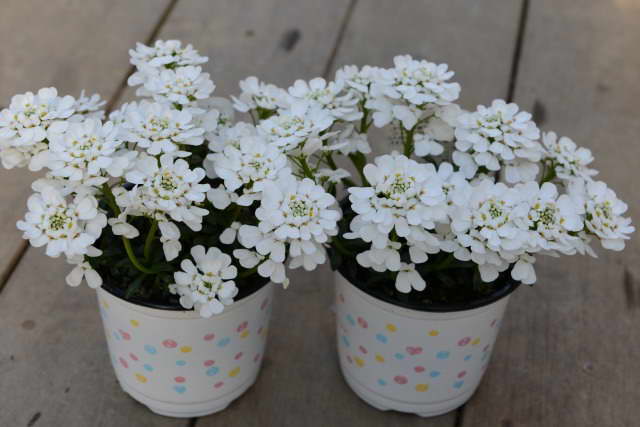

Blooming Iberis seedlings photo
With the onset of above-zero temperatures at night, without the threat of frost, the seedlings can be safely planted, this is the end of May - the beginning of June. Before planting, the seedlings are hardened for 10-12 days, taking them out to a shady place in the garden.
They are planted at the same depth in prepared holes without deepening the root collar. the distance between the bushes is 15-20 cm.
Choose sunny areas, as Iberis loves good lighting. The soil should be well-drained, without moisture stagnation. Sandy loam, sandy and rocky soils are perfect.
Reproduction methods
The plant reproduces in different ways: by seeds, cuttings, dividing the bush. The easiest way to reproduce is by seed. Seeds can be sown directly into open ground or grown for seedlings.
It is best to plant seeds in open ground in the second half of April. By this period, you no longer have to fear night frosts. But before sowing them, you need to make sure that the soil is warmed up enough.
Loamy or rocky soil in a well-lit area is most suitable for planting seeds. It is also important to ensure good drainage to avoid stagnant moisture. Iberis does not tolerate high humidity and in such conditions it can simply die.
Seeds are sown in pre-prepared holes no more than 10 cm deep, located at a distance of 10-15 cm from each other. The first shoots appear within 10-12 days. If the air is not heated enough, then the emergence of seedlings should be expected in 15-20 days. After their appearance, it is necessary to thin out the crops, leaving a distance between the bushes of at least 20-25 cm.
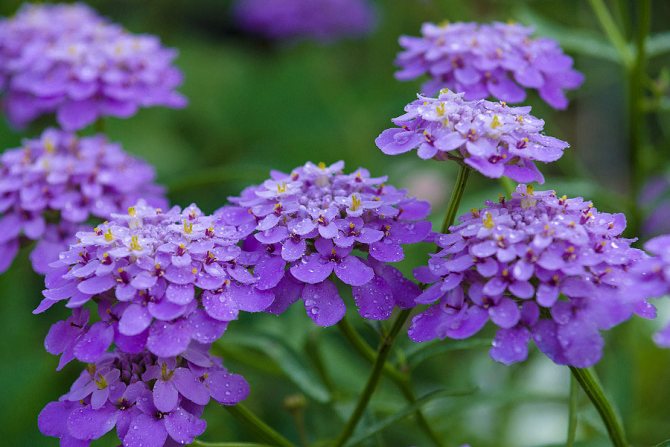

To ensure the constant flowering of Iberis, the seeds must be sown in several stages with a break of 2-3 weeks.
Sowing seedlings is best done in early March. To do this, you will need a low container filled with a loose, well-moistened substrate. Seeds are sown to a depth of no more than 1-2 mm. Sprinkle on top with a thin layer of fine river sand. The container is immediately covered with plastic or glass and sent to a warm, well-lit place.
Periodically, the container must be opened so that the crops could "breathe". Moisten the soil only with a spray bottle. The first shoots can be expected to appear in 1-4 weeks. As soon as sprouts appear, the shelter can be removed.
Young plants can be planted in open ground at the end of May. By this time, they will be strong enough and will be able to easily endure the cool of the night.Planting is best done in an open, sunny area with sandy, rocky or loamy soil. Seedlings are planted by transshipment, that is, together with an earthen clod, so as not to damage the fragile young roots. The distance between the seedlings is about 15 cm. The seedling is placed in a previously prepared hole, the soil around is compacted and the first moderate watering is carried out. Active flowering begins only in the second year.
Other breeding methods
Adult overgrown perennial bushes can be divided into several parts. It is best to carry out the procedure in early spring. The plant must be dug up, shaken off the excess soil and cut with a sharp knife at the base. Immediately plant all parts in the ground.
Iberis can be propagated by cuttings during the summer. To do this, cut off a shoot 8-10 cm long and place it in moist soil for rooting. Cover with a cap. When young shoots appear, the shelter can be removed. Transplant the rooted stalk together with the earthen clod to a permanent place. Creeping shoots are capable of giving roots during the growth process. They can be separated and moved to another location throughout the summer.
Propagation of Iberis by cuttings
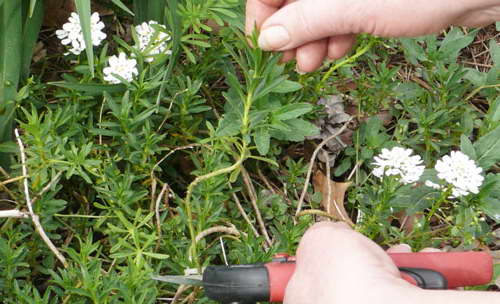

How to cut Iberis cuttings photo
Perennial species of Iberis reproduce successfully by cuttings in the month of June. Cuttings 10-12 cm long are cut and planted in moist soil. To stimulate root formation, you can soak the cuttings for 24 hours in a solution of epin, root or heteroauxin before planting. You can also root it in water, then planting ready-made seedlings in pots for growing. At the end of summer, new bushes are planted in a permanent place. So they will have time to take root well before the onset of cold weather.
Planting seedlings in the ground
When the daytime temperature rises to 16-18 degrees, and there is no threat of return frosts, Iberis seedlings are planted in the ground. The place should be sunny and well-drained. Rocky slides or terraces are ideal.
When placing Iberis among flowers that require frequent or abundant watering, a layer of gravel or broken red brick with a thickness of at least 10-15 cm must be placed on the bottom of the hole. Carefully remove the seedling from a plastic container or pallet. A peat cup is planted in the ground together with the Iberis. The soil is compressed, watered abundantly, mulched with peat or dry soil.
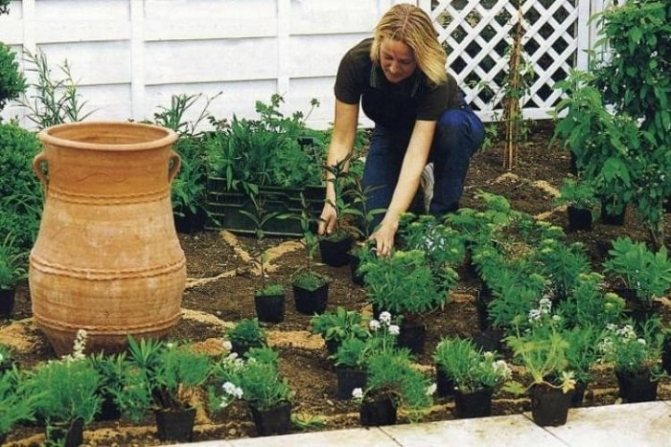

Planting seedlings in the ground
How to care for Iberis
Iberis easily copes with dry periods, but in order to fully reveal its decorative effect, it will still not be superfluous to water the flower bed at least once a week. Top dressing is not necessary, but if you are not too lazy and feed the Iberis with complex mineral fertilizer at least once or twice a season, the plant will respond with more lush flowering.
Fading flowers need to be cut off so that the plants do not lose their strength for seed ripening. Plus, the decorativeness of the plantings is so much higher, and the flowering is longer. At the end of the flowering period, the plant is pruned by a third to make the flower bed look well-groomed.
After 4-5 years, perennial Iberis thickens strongly and requires thinning with transplantation. By separating the bushes and planting them, the florist rejuvenates the plants and receives new planting material.
Sowing seeds for seedlings
Seeds for seedlings are sown in March. Shallow boxes are filled with sandy-peat soil. It is prepared according to this recipe:
- low peat - 5 parts;
- sawdust - 2 parts;
- coarse light sand - 3 parts.
Attention! Ground fine sand for seedlings can only be used after thorough rinsing.
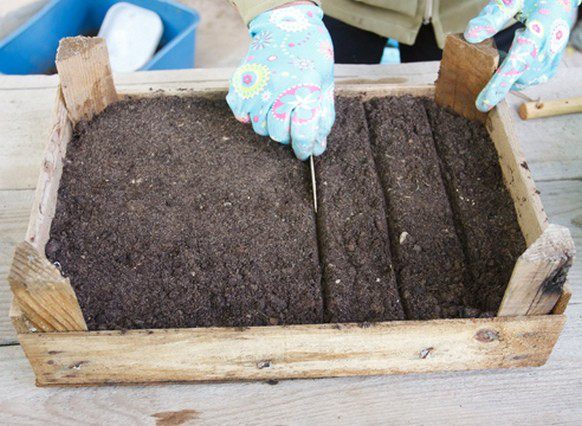

Seeds are sown in boxes with a peat-sand mixture
For each kilogram of the finished mixture, add:
- ammonium nitrate - 1.5–2 g;
- double superphosphate - 4–5 g;
- potassium sulfate - 3-4 g;
- ash - 1/20 cup.
The container intended for this is filled with loose soil and divided into cells using cardboard partitions. Boxes can replace peat pots.Seeds are placed on the ground, which are then easily pressed with the palm of your hand. A thin layer of river sand is poured on top.
To accelerate seed germination, create a greenhouse effect. The container with the planted material is covered with glass or foil and placed in a warm, bright place.
The glass is periodically removed to remove condensation. At this time, the moisture content of the soil is checked. If it is dry, then watering is carried out. The soil is moistened by spraying it with a spray bottle.
Double superphosphate prices
double superphosphate
Iberis in landscape design
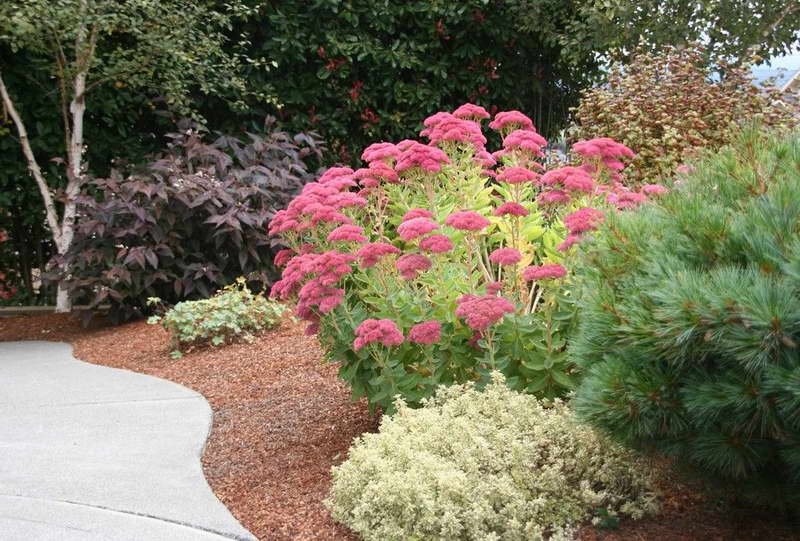

Iberis and spurge combination of flowers in a flower bed photo
Compact clumps of blooming Iberis look beautiful against the background of decorative stones in the rock garden. Monoplants are distinguished by their particular lightness, gentle romantic appearance.
Garden Iberis is distinguished by enviable durability and unpretentiousness, long flowering and a rich palette of possible shades. It is not difficult to grow this unpretentious plant from seeds, so the advice of our article will help you in this matter.
Medicinal properties and use in medicine
Peppermint is a medicinal plant in demand in folk medicine. Decoctions and tinctures from the roots, leaves and inflorescences of the plant are used:
- As a choleretic agent.
- In the treatment of gastritis and ulcers.
- As an antineoplastic agent.
- For quick healing and disinfection of wounds.
- Against gout.
- To relieve swelling and stimulate appetite.
When using folk remedies from Iberis, it is important to remember that the plant is poisonous. An allergic reaction or poisoning may occur if dosages are not followed.
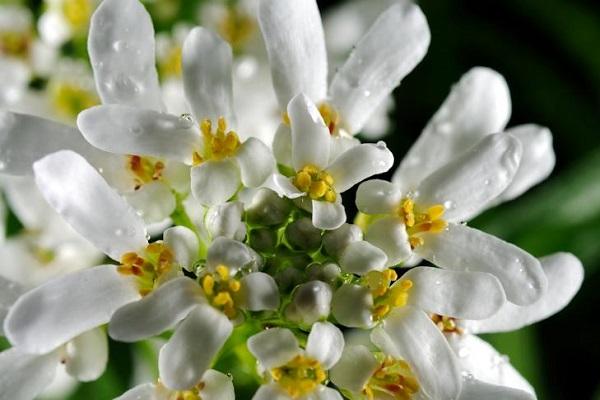

Description and varieties
In the wild, this plant prefers mountainous areas of Asia and southern Europe. Many varieties and types of Iberis are suitable for gardening, but the most popular are the breeding of the following.
What are the types of Iberis:
- Iberis umbrella... Differs in long flowering (up to two months), as well as spectacular umbrella inflorescences, for which it received its name. The height of the bush is up to 40 centimeters. The inflorescences are collected in round flat caps, tightly pressed against each other. Blossoms range from pure white (eg Giant Hyacinth flowered) to carmine red (Red Rush). But how the growing snow-white domes from the seeds of Hortensia is oak-leaved, you can see in this video.
Gibraltar Iberis... An interesting plant characterized by abundant decorative foliage and small inflorescences. Most often they are pink or lilac, but in open areas they can change color, gradually fading to snow-white. The height of the bush is up to half a meter, which is suitable for growing a small hedge or edging a curb. And here you can see how the curb stone looks in the photo.
Squit Candy belongs to the border plants... The characteristic color is snow-white or bright purple. Seedlings are planted in April or May, and in open ground it can be planted from mid-May.
Miniature varieties of Crimean Iberis are distinguished by lush flowering and the possibility of reproduction by cuttings... The buds have a lilac hue, and when blooming, they turn white. And in this video, you can see how the reproduction of Weigela by cuttings occurs.
Iberis rocky prefers mountainous areas with rocky soil, so it will perfectly decorate the alpine design of your site. Small bushes fill the entire space, therefore, with long-term cultivation, it is necessary to periodically thin out the plantings. But what fast-growing bushes for hedges look like, and how they can be planted, this information will help to understand.
Iberis bitter is an annual plant that reaches 30 centimeters in height. The characteristic aroma and long lanceolate leaves give this species additional appeal.
Perennial plants usually bloom more effectively, but this happens only in the second year of development. In this regard, annuals are simpler and more convenient. The lifespan of an adult Iberis is quite long, but usually by the third year it is advisable to "change" the bush in order to prevent the inflorescences from degenerating and crushing their configurations.
Popular types
About 40 varieties of Iberis are known, among which there are annual and perennial species.
Annuals are low herbaceous plants. They branch well and love warmth. The most popular are bitter and umbrella.
- Iberis is bitter. The shrub is about 30 cm high, with branching stems on which large serrated leaves grow. The inflorescences are composed of white crown flowers, outwardly resembling hyacinth. Flowers are often used in bouquets.
- Iberis is umbrella. An adult plant, depending on the species, has a height of 15-40 cm. During the flowering period, the bush is covered with small umbrellas, consisting of small flowers of lilac, carmine and pink shades. This type is often used for the decoration of borders and decoration of the alpine slide.
- Perennial Iberises tolerate frost well, prefer to grow on rocky and sandy soils in well-lit areas. Due to these features, they are often planted on rocky hills, in rockeries, and used in complex flower beds. Active flowering begins from the second year of the bush's life.
- Iberis is evergreen. One of the most popular perennials. An adult bush reaches a height of 35-40 cm. The leaves are oblong in dark green color. Thanks to the ability to maintain this color throughout the year, the plant got its name. The flowers are collected in umbrella inflorescences with a diameter of 4-5 cm, which completely cover the foliage during the period of the most active flowering.
- Iberis of Gibraltar. A native of Morocco and Spain. A compact bush up to 25 cm high. In the spring, small pink or lilac-purple flowers appear on it.
- Iberis is Crimean. This is a small bush 5-10 cm high with slightly pubescent foliage of a gray-green color. Flowering begins in spring. First, purple buds appear, after full disclosure, the flowers turn white.
- Iberis is rocky. An evergreen shrub with cylindrical leaves and white flowers, reaching a height of 15 cm. Its homeland is the rocky regions of southern Europe. During the period of active flowering, the bush looks like a dense curly cloud.
Planting methods
You can plant Iberis flowers in your garden with seeds, here the main thing is to find out when you can sow seeds, or seedlings.
Many gardeners prefer the first option, since the seedlings can be damaged during transplantation, but for cooler regions, it is worth choosing planting with seedlings.
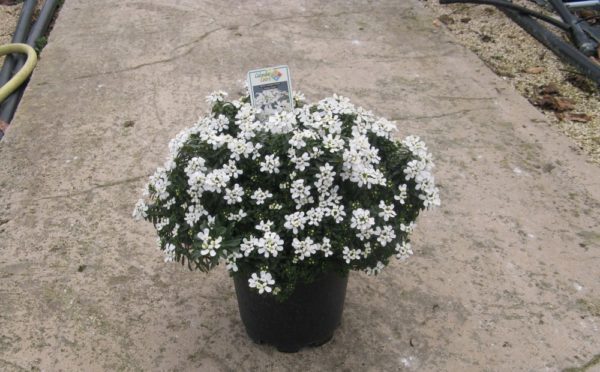

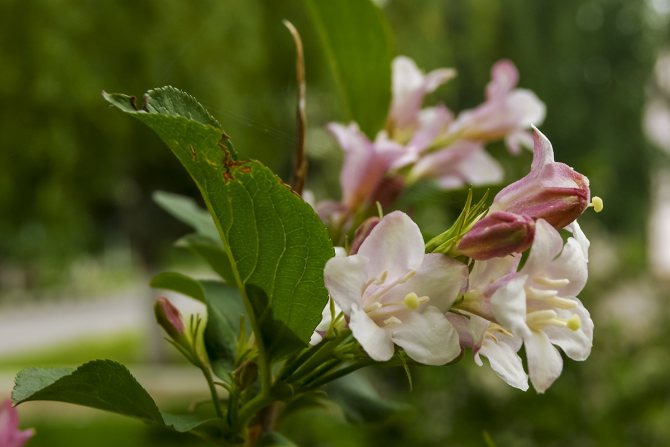

Testimonials
I planted Iberis with flowers, took root and built up a good green mass. Over the past season, it has doubled in diameter (at the moment, the diameter is 35 cm). The bush itself is low, only 20 cm. It blooms with beautiful white flowers. There is also Iberis and other colors. What I like about it is its fine leathery foliage. The bush is decorative at any time of the year, besides, Iberis is an evergreen plant.
Yulia_Tseknaser
Iberis has been growing by self-seeding for a long time. For earlier flowering, I sow a little on seedlings. This year I sowed for this only on April 11. I recommend sowing seedlings in a greenhouse, because Iberis seedlings cannot stand home heat, so they probably die.
Baba Galya
There are varieties of Iberis with double white and pink flowers. To preserve decorativeness after flowering, you need to cut off the twigs by at least 1/3 and then the bush begins to branch out and takes on a beautiful curtain appearance, which is preserved until autumn.
Tata
I learned about such a garden flower as Iberis only this year. In the spring I bought seeds and took them, as they say, without looking.I sowed the first variety of Iberis umbrella, sown directly into the ground, although you can plant them in seedlings (which I rarely do with garden flowers). There were not many seeds in the pack and I just sowed them in a small circle (unfortunately I did not save the packaging). Seedlings appeared in 10 days and after a month with a little, the first umbrellas opened. Soon the whole bush blossomed, after which I bought the seeds of Iberis hyacinthus and sowed around the umbrella. I have already saved this package and left a few seeds. Since it was already the first month of summer, in warm weather this variety emerged in a couple of days and now almost all of it has bloomed.
Aeternum
The first time I purchased the seeds of the Umbelliferae Iberis was about ten years ago. Growing this annual plant from seed was so easy that I have sowed it every year since then. The most important advantage of the umbelliferae is its cluster inflorescences, consisting of small lilac, pink, purple or white flowers with four petals. Iberis brushes resemble umbrellas in shape, hence the specific name of the plant. I always sow Iberis in mid-May, when it is already warm enough and the daytime temperature is around +18 ºC. In such conditions, seedlings appear in about two weeks.
Svetlana Nikolaevna
Iberis is a versatile and unpretentious ornamental plant that is very popular with experienced gardeners and beginners, landscape designers and florists. Subject to all the rules for growing and caring for plantings, it will be an ideal decoration for any garden.
Choosing a place and partners for Iberis
Suitable for alpine slides, rocky gardens, stone areas, looks great in combination with wild stone and decorative masonry. Borders and borders of Iberis in flower beds and flower beds look catchy. Evergreen Iberis is combined with saxifrage, spiked phlox, sedum, rocky alyssum. Different types of Iberis, planted together, also look good. This method, due to over-pollination during flowering, is not suitable if it is planned to collect seeds from plants for breeding.
Description of the plant
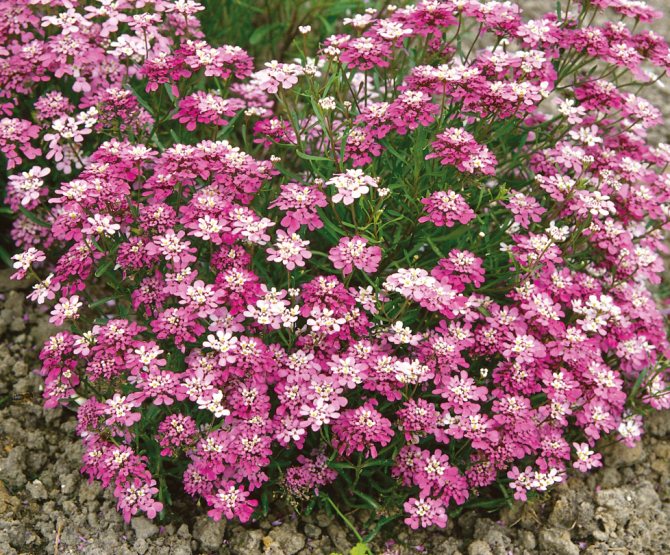

The stenicum is distinguished by its well-developed main root in comparison with the lateral roots. Stems in some species grow upward without any support, in others the stems creep, the average height is 35 cm. The arrangement of oblong bright green leaves, 7 cm long, is alternate. Blossom in summer, some species in spring. Inflorescences - an umbrella, consist of tiny flowers with a diameter of 1.5 cm. The colors of flowers of representatives of different species and varieties of stennik are varied: petals of lemon, violet, pink, snow-white. The flowers exude a delicate pleasant aroma. The culture is known as a great honey plant. The fruit of the plant is a medium-sized flattened pod with tiny brown seeds that retain the ability to germinate up to four years.
Seeds
As a rule, frost is no longer expected in mid-April, which means that you can start planting Iberis and growing it from seeds, the main thing is to study all the intricacies of caring for such a beautiful plant as in the photo. But if in April the temperature is below + 10 ° C and the soil is not warmed up, the planting of a perennial plant should be postponed until the end of the month.
The peculiarities of planting Iberis is that the site is illuminated and drained, since an excess of moisture is very dangerous for such a plant, the flower can be destroyed. As for the soil, the best option is rocky or loamy soil.
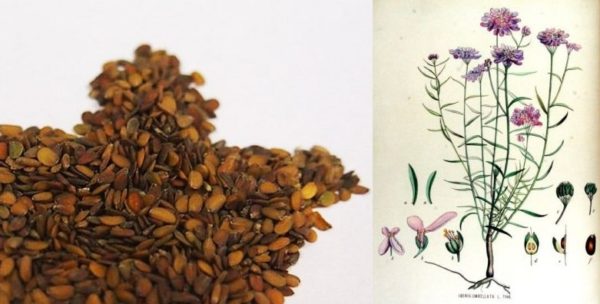

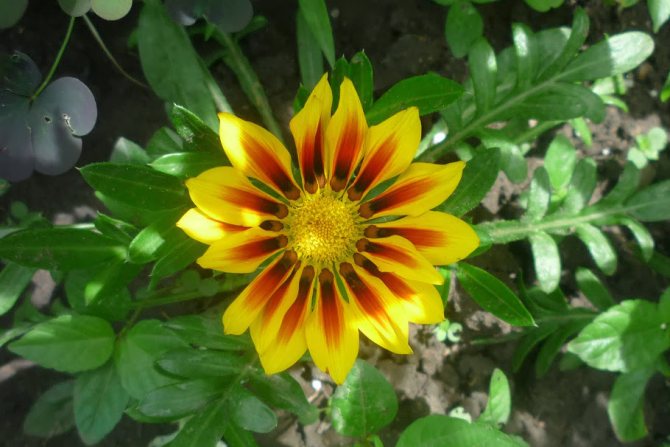

Tips for caring for Iberis in your garden
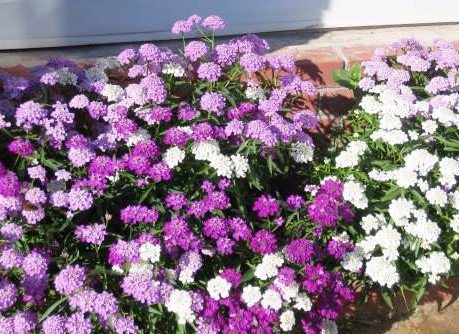

Iberis itself is lush and grows well, therefore, when planning your garden, you need to calculate in advance a place for it. In general, plant care is very simple. Watering in a timely manner, avoiding strong drying out of the soil, watering is always moderate. Top dressing in the soil for Iberis can not be applied at all, but if you feed it before flowering, then it will be more friendly and abundant.It is necessary to remove the faded inflorescences and cut the stems by a third after flowering. After five years, it is better to plant Iberis - otherwise the flowers will become smaller.
Appreciate the beauty of an overseas flower
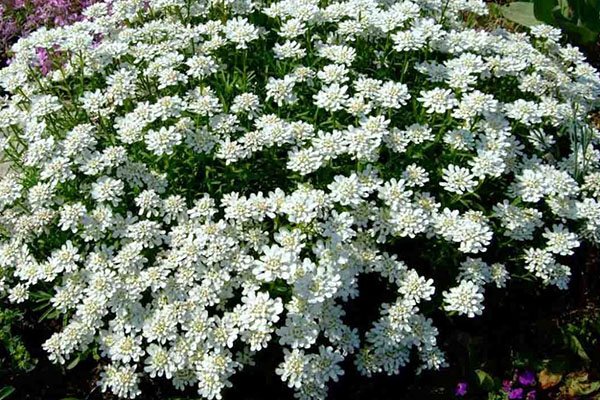

Almost all types of stennik are stunted plants that gracefully spread along the ground. Thanks to this, with its help, original garden landscapes are created. Iberis evergreen feels great among the stones on the alpine hills. When flowers bloom in early spring against the background of dark green leaves, there is no limit to admiration.
The plant is prized for its external beauty and unsurpassed aroma. This fact should be taken into account by those who are allergic to odors.
A stunted shrub of Iberis grows up to half a meter. It has many dense branches, which are tree-like at the bottom of the bush, and tender and flexible at the top. Small, dark green leaves are located close to each other, creating a solid head. Shoots usually grow vertically upward, spreading in nature. A photo of evergreen Iberis will help you to consider all its charms.
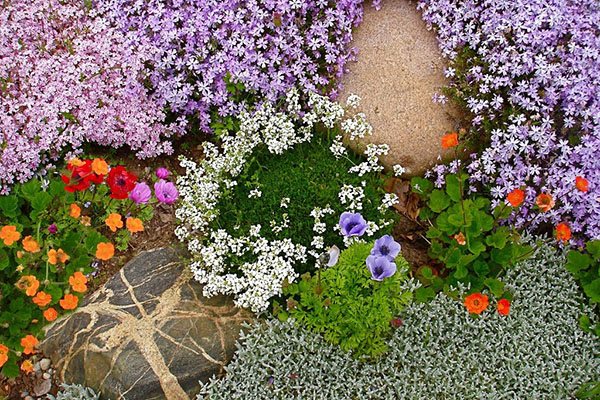

The types of this plant known today are:
- Bitter. It is a low-growing version up to 30 cm. The flowers are white with a delicate purple tint.
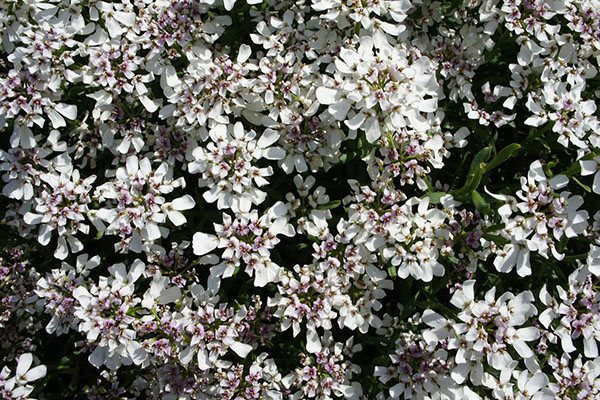

- Umbrella. Annual plant, up to 40 cm high. Dense inflorescences of pink or lilac hue. They have a strong aroma.
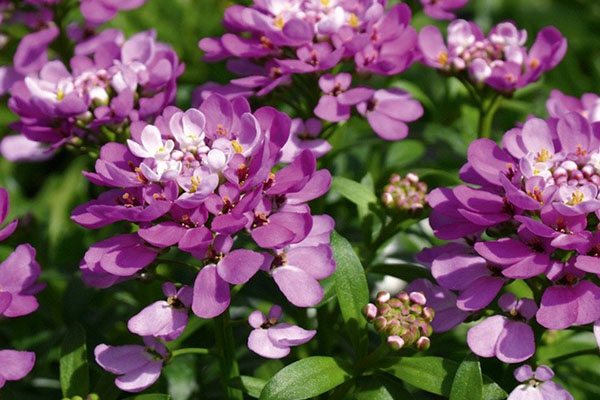

- Gibraltar. Perennial shrub. Has corymbose inflorescences of lilac color.
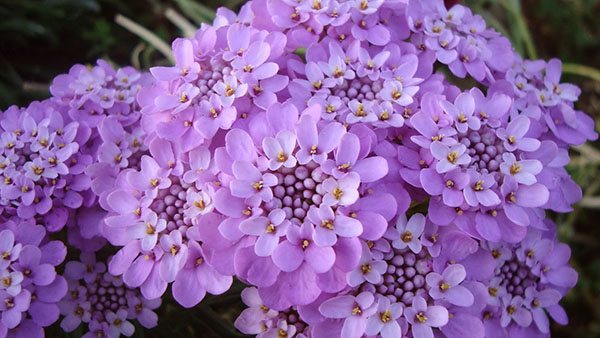

In general, we can say that Iberis is an original fluffy plant with an unusual flow of inflorescences.
Landing in open ground: questions and answers
We answer popular questions related to Iberis, its planting and care in the open field.
When to plant?
In order for the plant to take root well, planting in open soil is carried out when the frost has passed. This is usually mid-May. Choose a site with good access to the sun, rocky ground. Too wet soil will not work. Stagnation forms in the roots, which has a bad effect on the root system.
How is the disembarkation done?
- The seedlings are removed from the container in which they were grown. The procedure is performed very carefully so as not to injure the root. To do this, you can take a seedling along with a lump of earth.
- Bushes are planted in the soil at a distance of 12-15 centimeters.
- The earth is carefully rammed, the sprouts are watered.
- A little trick for those who would like to get Iberis of different colors and decided to plant a variety of varieties. Maintain a decent distance between the bushes - they can get dusty.
Further reproduction is possible by cuttings, division.
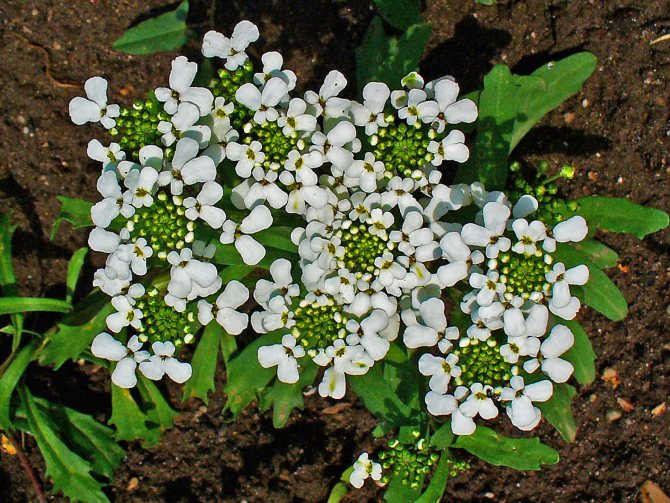

It is better to plant Iberis in late spring, after the last frost.
Content
- Listen to the article
- Description
- Growing Iberis from Seed Sowing
- Seedling care
- When to plant
- How to grow
- How and when to collect seeds
- Iberis bitter (Iberis amara)
Common diseases and pests
Let's start with the pests that are dangerous to Iberis. Earthen fleas feed on leaf plates - they eat large holes in them. Mealy worms and aphids settle on the flowers, from which you should not expect anything good either. Potash soap is considered to be a good means of fighting aphids. Dissolve 200 g of the substance in 5-6 liters of water. The resulting solution is used to treat infected flowers. After seven days, the procedure is repeated.
How to get rid of mealybugs that have chosen evergreen Iberis? Bushes are treated with phytoverm, mospilan. After 7 days, it is recommended to repeat the procedure to consolidate the result.
Fungus is another common attack of the Iberis genus.The easiest way to prevent the problem is to try to cure plants already affected by the fungus. Before planting, a plot of land is treated with fungicides. Are the roots already rotting? Affected specimens are dug up and burned, the place of growth is carefully processed.
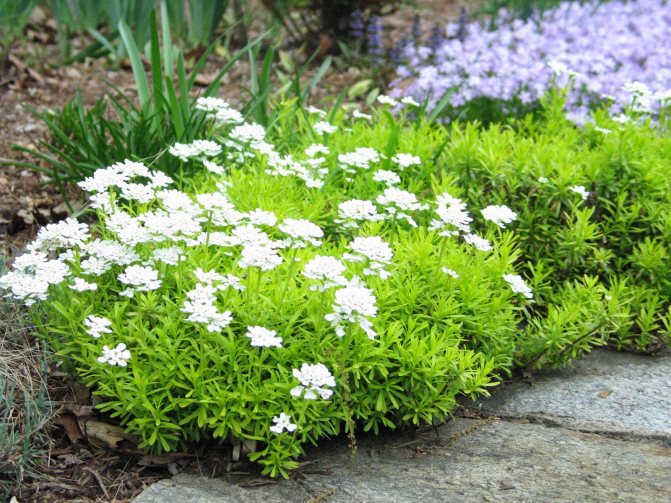

There are not so many pests of this plant, therefore, with proper care, Iberis will not create problems for you.
Seed collection
In place of the faded flowers, seeds are formed. Seeds can be harvested all season. There is no point in waiting for autumn - you can stock up on seeds in summer.
The pods are collected and dried in the shade in the air. You can dry the pods in a warm room. Then the seeds are extracted from them and stored in cardboard boxes or bags made of natural fabric in a cool and always dry room.
Many growers do not collect seeds at all, but allow the plant to multiply by self-sowing. In the spring, all that remains is to thin out the friendly shoots on the last year's site.
Planting and leaving Iberis
Selecting and preparing a landing site
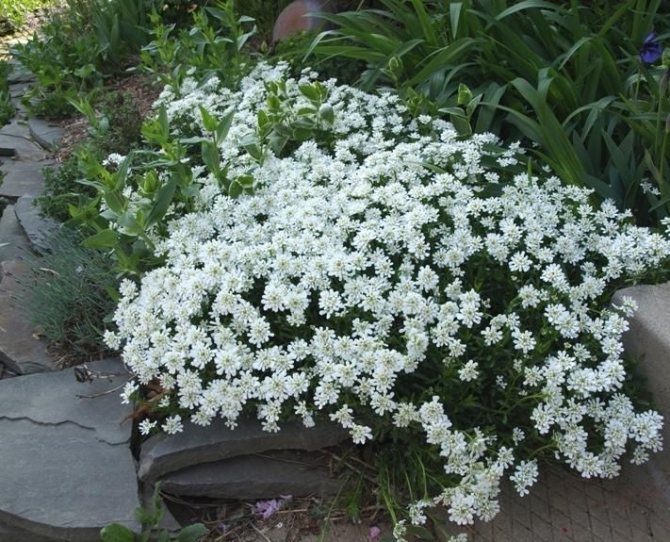

The best place for planting a stencil will be a sunny place. But, if this is not possible, then an unpretentious culture can grow in partial shade. In the shade, it will not be able to bloom so violently, but it will retain its decorative effect. The choice of soil is also not of fundamental importance, but preference is given to loamy and light soil. The negative effect of stagnant moisture on garden plantings provides for a good drainage layer when planting and choosing a site without stagnant groundwater and melt water. In order for the Iberis to take root better, gardeners choose dry weather for planting it.
Planting and feeding
When planting, the distance from hole to hole should be at least 25 cm. This will help each specimen get enough sunlight and food.
After planting, the soil around the plant is watered and compacted. The next watering does not occur soon: after the Iberis has adapted to the new environment. In the future, the need for moisture will rarely appear, with a prolonged dry period.
Top dressing occurs twice during the season... As soon as the first leaves appeared, mineral fertilizers are used. The budding period requires organic feeding from the caring owner.
Plant care and pests
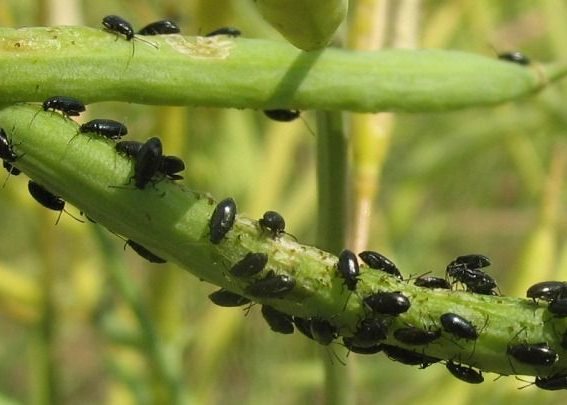

Cruciferous flea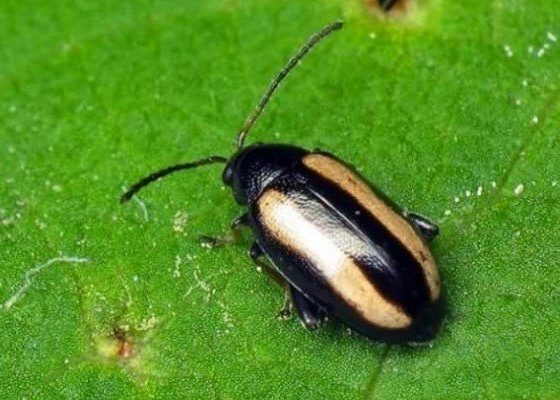

Cruciferous flea
Its unpretentiousness and ability to adapt to environmental conditions make it easy to clean. Special conditions and the need to devote a lot of time to courtship - this is not about Iberis. It is enough for him to provide thinning (during the first shoots), timely pruning of stems, transplanting every 5 years and protection from insect pests and diseases. The latter are often found cruciferous flea... It negatively affects the growth of the bush and forms holes in the leaves. When the first symptoms appear, urgent action is needed. The plant is sprayed with systemic insecticides. In order to avoid such attacks, it is better to immediately treat the soil with a fugnicide solution before planting. Such preventive measures will help to avoid dangerous consequences for the list.
The most popular disease is a fungus of various types.... Keela cabbage can live in the ground for more than 10 years. Therefore, preventive treatment of the land before planting is required. The disease is incurable. For young representatives, this ailment is fatal. Older adults are able to grow with it for a long period, but over time, growth stops.
Outcomes
The light charm of fragrant iberis blossoms will be a good addition to any landscape. Plants feel great in our climatic zone, they are easy to care for. If you plant a pepper pot along the edges of the curb, they will shine with new colors, they will look very extraordinary. The delicate palette of the stennik goes well with any culture, therefore, in the rock gardens and rocky hills, a representative of the cabbage genus will definitely take its place.An especially successful ensemble will turn out in combination with large-flowered bells, undersized marigolds, phlox. And with neighbors such as cypress and dwarf pine, Iberis will always live peacefully and amicably.

